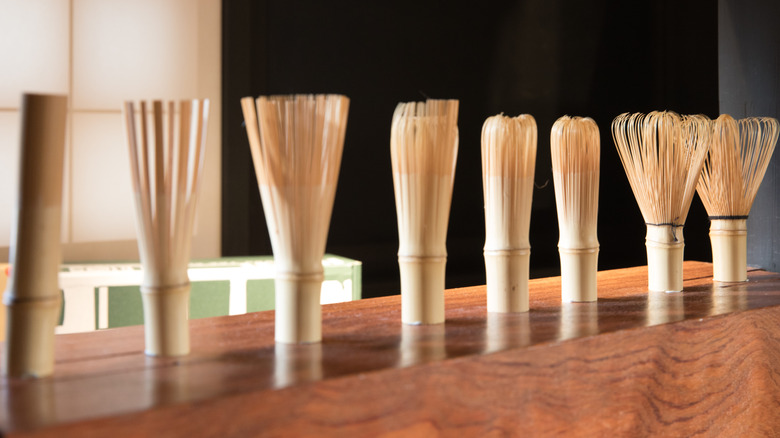How To Choose The Best Bamboo Whisk For Your Matcha
Traditionally called a chasen, the bamboo matcha whisks you've been ordering off Amazon are likely mass-produced somewhere outside of Japan. Originally, however, they came from a small bamboo village known as Takayama, where they were made by hand. The highest quality bamboo whisks are still made there to this day, with one of the 18 remaining "chasen masters" taking a single piece of bamboo and painstakingly splitting it into anywhere from 60 to 100 delicate prongs — a number you'll want to take note of next time you're shopping for one.
It might sound silly to make such a fuss over a whisk, but traditional Japanese tea houses are at the intersection of food and art — and every single element is equally as important as the tea itself. Within traditional tea ceremonies, one of two styles of matcha is served: the thicker style known as koicha and the thinner style known as usucha.
Matcha whisks come in many styles but usually have one of three prong counts: 60, 80, or 100. While 80-pronged whisks, the most common of all whisks, will work for either style of matcha, 60-pronged whisks are best for preparing usucha — leaving the 100-count for the thicker style, koicha. Read up on why you should mix matcha with a bamboo whisk and it will all make sense.
Respect the whisk, no matter the prong count
Now, you might not all be ordering your bamboo whisks from Takayama, Japan — but that doesn't make them any less valuable of a tool as it pertains to your matcha. No matter if your bamboo whisk has 60 prongs or 100, your whisk is a historically indispensable element in matcha preparation, with hundreds of years of cultural significance and tradition under its belt — and it deserves to be treated as such. In turn, there are some specific care instructions that must go into maintaining them and your matcha's frothiness.
First, you're going to want a stand. Most bamboo whisks come with them, but they're important for maintaining the whisk's shape. Secondly, you should be soaking your matcha whisk before every use — not just to get the best results, but to keep those precious prongs from snapping. Lastly, it's important that you handwash your whisk after you use it. Never with soap though, which will make it more prone to breaking. Just rinse in warm water before placing it on the stand.
Now, if you're drinking matcha every day and that sounds like a little too much upkeep, that's okay. You might want to look into getting yourself a resin whisk instead. They're dishwasher safe, won't break, and, unlike those metal milk frothers, actually have an adequate number of prongs. Then, you can save your bamboo one for more special occasions.

